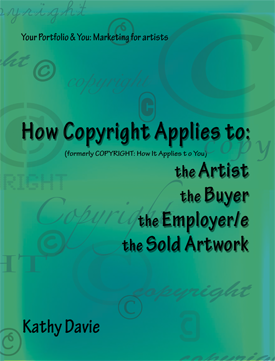- Print list price: $8.95
- Download list price: $4.95
- ISBN: 978-0-557-77048-9
- Published: Nov 2010
- Publisher: Lulu.com
- Number of pages: 42
- Book detail: Black-and-white paperback with color cover, 8.5″ x 11″
- Number of downloadable files: 3
THE PURPOSE:
Such a simple thing, a symbol, four numbers, and a name to have such huge ramifications on everyone connected to a particular piece of art, a product, a process, an idea. The physical manifestation of an idea, the marketing and treatment of that idea, the protection society requires for its creator all bound up in © YYYY First and Last Name.
The focus in How Copyright Applies is aimed at fiber artists and yet the explanations and examples are applicable to artists of any media, scientists, writers, engineers, laborers,
With so many myths and exceptions swirling about, I decided that I needed to understand exactly what was required to protect my work—and the most efficient way in which to go about it. It can get expensive! And I discovered it can get expensive in more ways than one.
There are also two sides to every coin: you as the employer and you as the employee. When you add in the different types of licensing and assigns…what are assigns??…It’s just too confusing, until now.
Table of Contents in Copyright
- Introduction
- How Does Copyright Work (for Me)?
- Where to Place a Copyright Notice
- Readily Viewable
- Common & Statutory Copyright Law
- Registering Your Copyright
- Paying for Your Copyright
- Submitting the Image/Product Being Copyrighted
- The Group Copyright
- Poor Man’s Copyright
- Where to Place a Copyright Notice
- You’ve Sold an Artwork!! Now What…
- Exceptions to Copyright
- Modification & Mutilation Protection
- Ownership Life of a Copyright
- Ownership Life for a Work-Made-For-Hire
- Licensing, Royalties, Fees
- Pluses & Minuses of “Assign”
- Exclusive versus Non-Exclusive
- Showing Work After It’s Sold
- Copyright Ownership as It Relates to “Work-for-Hire”
- “Work-for-Hire” Defined
- Components of a Work-for-Hire Agreement
- Handling “Work-for-Hire” Clauses in a Contract
- As the Contractor / Employee
- Assigning Away Your Rights
- As the Employer
- As the Contractor / Employee
- Bibliography
- Appendix A: Copyright Release Forms
- Appendix B: “Work-for-Hire” Agreement Example
- Appendix C: List of URLs, Forms, & Publications
Copyright is all about…
All the in’s and out’s of copyright: how it works for you as the artist (and the seller!), the employee, the employer. So many myths surround copyright protection and there is so little information about how it affects the artist, the buyer, and the public.
Read on and discover all the essential trivia you never knew you needed to know. Proper placement and formatting of the copyright. The exceptions. How long copyright protection is in effect. Dealing with exclusive and non-exclusive licensing and royalty fees and assignments.
The most useful information involves which forms to use, the Copyright Office requirements for images, how to save money when applying for a copyright, website addresses are included for the relevant forms along with downloadable examples of copyright release forms and a work-made-for-hire contract.
Downloadable Forms from How Copyright Applies to You
Three starter forms to help you protect yourself and your work:
- Simple Artist Release Form (primarily for publications)
- General Artist Release Form (most useful for “Work-for-Hire” situations)
- Example of a “Work-for-Hire” Agreement
From Chapter 1: How Does Copyright Work (for Me)?
Common & Statutory Copyright Law
Technically, as long as you mark your original artwork with “© 1999 Your Name”, no one else may use your image to produce anything, which they then sell; this is known as “common copyright law”. (If you don’t plan to sell the work, it is sufficient to use a © Your Name; if offering to sell, add the year in which you first offered it up for sale.)
If, however, someone does start selling images of your original piece, you must…more
Poor Man’s Copyright
The poor man’s copyright? No. Mailing a slide of the work to yourself so you’ll have the proof of the postmark (and you can never open it) is too hard to prove. And DNA testing is expensive. You’d spend a heckuva lot more trying to prove it than if you had just spent the 35 bucks…
The safest action is to consider…more
From Chapter 2: You’ve Sold an Artwork!!! Now What…
You may have sold the work. You have not sold the copyright. It doesn’t matter who owns the actual work. The person who owns the copyright is the only one who has the legal right to sell images of the work, create derivative work (variations on the original), submit images for publication, or show the actual work in public. Copyright means “the right to copy”.
Exceptions to Copyright
There are two exceptions. Copies can be made for non-profit educational use, displaying in a non-profit, educational, or religious space or as part of a news story. The second exception is that the owner of the work is allowed to exhibit it (with your name noted as the creator of the work) for non-profit educational organizations and in private, or in public with the artist’s permission. Whenever the work is shown, as the artist you have a right to expect that your name will be noted as the creator of the work although your name can’t be used without permission.
Modification & Mutilation Protection
The work itself is protected from distortion, mutilation, or other modification that would be prejudicial to the artist’s …more
From Chapter 3: Copyright Ownership as It Relates to “Work-for-Hire”
Components of a “Work-for-Hire” Agreement
While there is an example of a work-for-hire agreement in Appendix B, it’s always good to understand its components. Know what you want this agreement to encompass. At a minimum, your agreement should include:
- A description of the artist/photographer/videographer/author/composer/programmer’s tasks
- Which party is responsible for providing information, materials, or legal releases
- Terms of payment (ideally, break it down into partial payments due upon completion of some portion of the task)
- Who covers which expenses
- Completion deadlines
- Bonus for early completion
- Reductions for late or defective completion
- Extensions for untimely response on the part of the employer
- Expected end result, i.e., original artwork; slides, photographs, or digital images; video; article or book; lyrics and/or instrumentals; software program, etc.

Kathy Davie is an editor, author, and artist with degrees in Technical Writing & Editing, Digital Media, and History from Metropolitan State College in Denver, Colorado.
A huge believer in knowledge being power, Kathy has an ongoing and free set of Author Tools for authors interested in self-editing with an ongoing series of posts on Word Confusions, what’s Properly Punctuated, those tricky Formatting Tips, and the sleep-inducing Grammar Explanations. There is also an online tutorial on Using Microsoft Word’s Markup Tool.
And if you get too sleepy, explore KD Did It for various writing and editing services.


Leave a Reply